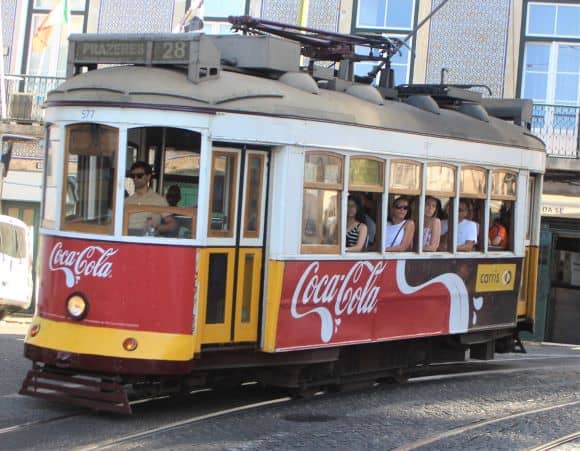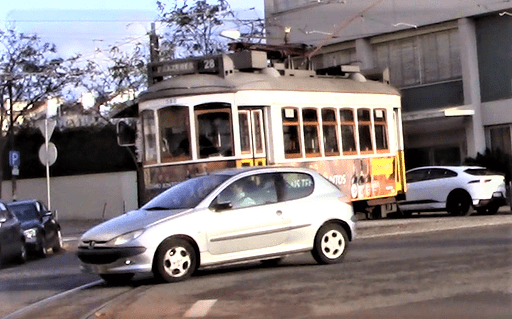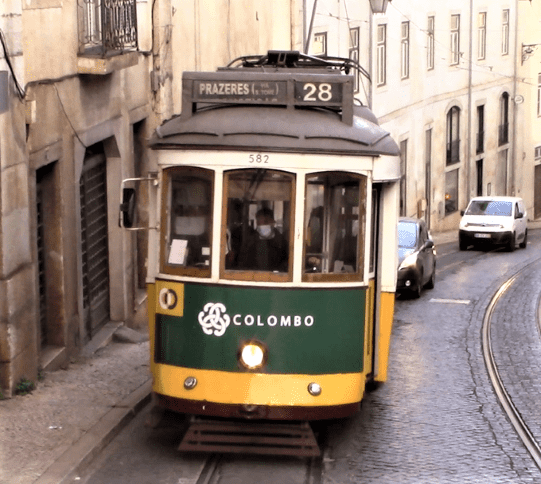Lisbon’s trams have become a symbol of the city. And riding the tram is a great way to see many of Lisbon’s top sights.
Lisbon’s Tram Origin Story
Trams began hauling Lisboetas from place to place in 1873. Back then, trams were powered by horses.
But, there was a problem. Lisbon has many steep hills and the horses couldn’t pull the trams up these inclines. So, in 1884, trams with cable lines were implemented to get the cars up and down hills. Eventually, several of the cable line “Elavadors” were put into service.
In 1901, the tram system was electrified, making it much more efficient. The tram system grew in popularity and more lines were built, peaking in 1959 with 27 tram lines.
In recent years, the convenience of the newer Metro system has caused the trams to be less popular. Several lines have been discontinued and there are now six operating in Lisbon.
Those Charming Tram Cars

The yellow tram cars in Lisbon are called Remodelado because they were remodeled in the 1990’s. But, they still retain their original character from when they were built in the 1930’s. The polished wooden interior and hard benches are a dapper relic from an earlier time. Then there’s the chrome wheel and the bell that the driver uses to warn cars and pedestrians.
You might ask why a modern city like Lisbon still uses these old-timey carriages. The answer might surprise you. While they are striking visually, the fact is that replacing the carriages would be quite difficult.
That’s because of Lisbon’s street design.
The streets in many parts of Lisbon are very narrow, have steep inclines, and very sharp turns. Just ride one of the trams and you’ll see for yourself that the carriages squeeze through tight quarters all the time.
So, the tracks for the trams were built using an unusually narrow gauge that is not used in other cities. Modern tram building companies don’t manufacture carriages to this standard so if Lisbon were to buy new trams, they would have to build an entirely new tram network!
Tram 28

For tourists, Tram 28 is, by far, the most popular line in Lisbon. The route runs from Martim Moniz to Campo de Ourique and it passes by some of the best sites in the city like Miradouro de Santa Luzia, the famous cafe A Brasileira, Jardim da Estrela, and Saint Anthony’s Church.
The entire trip from Martim Moniz to Campo de Ourique (or vice versa) usually takes less than an hour (depending on traffic).
How to Ride Tram 28

You can pay cash when getting on the tram, but a far more efficient (and less costly) way is to buy your ticket in advance. Get a Viva Viagem card and buy a 24 hour public transit pass. Or, you can load your card with money and use it as you like over several days or weeks. Note that you cannot buy a 24 hour pass AND load money for a longer period of time on the same card (confusing, I know). Viva Viagem cards are available at Metro stations, ferry terminals and some kiosks around the city.
Once you have your card, you can ‘zap’ it on the card reader on the tram when you get on.
A few things to be aware of when riding the tram:
• The tram makes sharp turns and sudden stops and starts. Hang on tight!
• Give up your seat to elderly or pregnant passengers.
• Watch for pickpockets. They target tourists, especially when getting on/off the tram.
• The tram is a functioning commuter rail system first and a tourist attraction second. Be respectful of those trying to get to and from work and doing their daily errands.
• Tram 28 runs from point to point. If you ride to the end, you have to get off and then get back on the tram (paying again) if you want to go back.
Tram Alternatives
Tram 28 isn’t the only game in town.
Tram 12 uses the classic Remodelado carriages, goes through the Baixa and Alfama neighborhoods and even departs from the same place as 28, Martim Moniz Plaza.
Tram 24 goes through less touristy neighborhoods but still uses the Remodelado carriages. It’s less busy, so you can usually get a seat.
If you’re going to Belem (and you def should), take Tram 15. Note that this is a modern tram, not a Remodelado.
Of course, if you’re not concerned with the charm of a Remodelado tram, use the subway. It’s super fast and convenient.
About the Author

Brent Petersen is the Editor-in-Chief of Destination Eat Drink. He currently resides in Setubal, Portugal. Brent has written the novel “Truffle Hunt” (Eckhartz Press) and the short story collection “That Bird.” He’s also written dozens of foodie travel guides to cities around the world on Destination Eat Drink, including in-depth eating and drinking guides to Lisbon, Porto, Sintra, Monsaraz, and Evora in Portugal. Brent’s podcast, also called Destination Eat Drink, is available on all major podcasting platforms and is distributed by the Radio Misfits Podcast Network.
